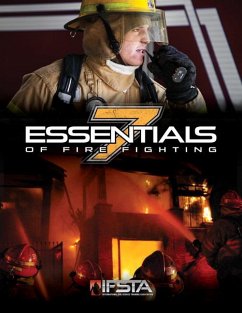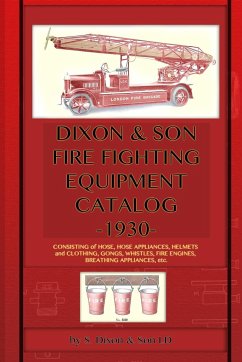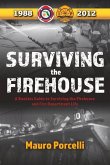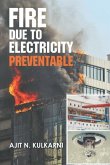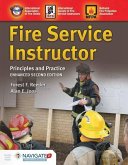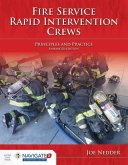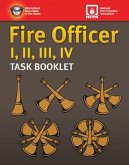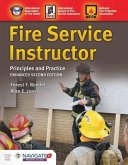Ifsta
Essentials of Fire Fighting
Ifsta
Essentials of Fire Fighting
- Broschiertes Buch
- Merkliste
- Auf die Merkliste
- Bewerten Bewerten
- Teilen
- Produkt teilen
- Produkterinnerung
- Produkterinnerung
For courses in the essentials of fire fighting. Foundations for success in professional fire fighting Essentials of Fire Fighting and Fire Department Operations continues the tradition of excellence in firefighter education. It meets all the requirements of Fire Fighter I and II levels of NFPA 1001-«, NFPA 472-«, and OSHA 1910.120. The 7th edition offers a complete support package, including skill sheets, knot and rope requirements, and coverage of essential job tasks related to medical requirements of NFPA 1582-«.
Andere Kunden interessierten sich auch für
![Dixon & Son Fire Fighting Equipment Catalog -1930- Dixon & Son Fire Fighting Equipment Catalog -1930-]() S. Dixon & Son LDDixon & Son Fire Fighting Equipment Catalog -1930-13,99 €
S. Dixon & Son LDDixon & Son Fire Fighting Equipment Catalog -1930-13,99 €![Surviving the Firehouse: A Rookies Guide to Surviving the Firehouse and Fire Department Life Volume 1 Surviving the Firehouse: A Rookies Guide to Surviving the Firehouse and Fire Department Life Volume 1]() Mauro PorcelliSurviving the Firehouse: A Rookies Guide to Surviving the Firehouse and Fire Department Life Volume 118,99 €
Mauro PorcelliSurviving the Firehouse: A Rookies Guide to Surviving the Firehouse and Fire Department Life Volume 118,99 €![Fire Due to Electricity Fire Due to Electricity]() Ajit KulkarniFire Due to Electricity33,99 €
Ajit KulkarniFire Due to Electricity33,99 €![Fire Service Instructor: Principles and Practice: Principles and Practice Fire Service Instructor: Principles and Practice: Principles and Practice]() Forest F. ReederFire Service Instructor: Principles and Practice: Principles and Practice153,99 €
Forest F. ReederFire Service Instructor: Principles and Practice: Principles and Practice153,99 €![Fire Service Rapid Intervention Crews: Principles and Practice Fire Service Rapid Intervention Crews: Principles and Practice]() Joe NedderFire Service Rapid Intervention Crews: Principles and Practice140,99 €
Joe NedderFire Service Rapid Intervention Crews: Principles and Practice140,99 €![Fire Officer: Principles and Practice Includes Navigate Preferred Access Fire Officer: Principles and Practice Includes Navigate Preferred Access]() Michael J WardFire Officer: Principles and Practice Includes Navigate Preferred Access151,99 €
Michael J WardFire Officer: Principles and Practice Includes Navigate Preferred Access151,99 €![Fire Service Instructor: Principles and Practice: Principles and Practice Fire Service Instructor: Principles and Practice: Principles and Practice]() Forest F. ReederFire Service Instructor: Principles and Practice: Principles and Practice183,99 €
Forest F. ReederFire Service Instructor: Principles and Practice: Principles and Practice183,99 €-
-
-
For courses in the essentials of fire fighting. Foundations for success in professional fire fighting Essentials of Fire Fighting and Fire Department Operations continues the tradition of excellence in firefighter education. It meets all the requirements of Fire Fighter I and II levels of NFPA 1001-«, NFPA 472-«, and OSHA 1910.120. The 7th edition offers a complete support package, including skill sheets, knot and rope requirements, and coverage of essential job tasks related to medical requirements of NFPA 1582-«.
Hinweis: Dieser Artikel kann nur an eine deutsche Lieferadresse ausgeliefert werden.
Hinweis: Dieser Artikel kann nur an eine deutsche Lieferadresse ausgeliefert werden.
Produktdetails
- Produktdetails
- Verlag: PRENTICE HALL
- Seitenzahl: 1664
- Erscheinungstermin: 21. Oktober 2021
- Englisch
- Abmessung: 284mm x 219mm x 50mm
- Gewicht: 3055g
- ISBN-13: 9780134985664
- ISBN-10: 0134985664
- Artikelnr.: 57830499
- Herstellerkennzeichnung
- Libri GmbH
- Europaallee 1
- 36244 Bad Hersfeld
- 06621 890
- Verlag: PRENTICE HALL
- Seitenzahl: 1664
- Erscheinungstermin: 21. Oktober 2021
- Englisch
- Abmessung: 284mm x 219mm x 50mm
- Gewicht: 3055g
- ISBN-13: 9780134985664
- ISBN-10: 0134985664
- Artikelnr.: 57830499
- Herstellerkennzeichnung
- Libri GmbH
- Europaallee 1
- 36244 Bad Hersfeld
- 06621 890
About our author The International Fire Service Training Association (IFSTA) was established in 1934. The mission of IFSTA is to identify areas of need for training materials and foster the development and validation of training materials for the fire service and related areas. IFSTA is an association of fire service personnel who are dedicated to upgrading fire fighting techniques and safety through training. The IFSTA Validation Conference is held each July. Committees of technical experts meet and work at the conference addressing the current standards of the National Fire Protection Association and other standards-making groups as they apply to IFSTA-validated manuals. These committees also meet in January and throughout the year as necessary. These technical experts review all manual drafts and verify that the contents are valid. Committee members are all volunteers who participate because of a commitment to the fire service and its future through training. Fire Protection Publications, a department of the College of Engineering, Architecture, and Technology at Oklahoma State University, is the headquarters for IFSTA. Fire Protection Publications' primary function is to publish and disseminate training manuals as proposed and validated by IFSTA. Fire Protection Publications researches, acquires, produces and markets high-quality learning and teaching manuals that complement the IFSTA-validated manuals.
Section A: Fire Fighter I
1. Introduction to the Fire Service and Firefighter Safety.
2. Communications
3. Building Construction
4. Fire Dynamics
5. Firefighter Personal Protective Equipment
6. Portable Fire Extinguishers
7. Ropes and Knots
8. Ground Ladders
9. Forcible Entry
10. Structural Search and Rescue
11. Tactical Ventilation
12. Fire Hose
13. Hose Operations and Hose Streams
14. Fire Suppression
15. Overhaul, Property Conservation, and Scene Preservation
Section B: Fire Fighter II
1. Building Materials, Structural Collapse, and Effects of Fire Suppression
2. Technical Rescue Support and Vehicle Extrication Operations
3. Foam Fire Fighting, Liquid Fires, and Gas Fires
4. Incident Scene Operations
5. Fire Origin and Cause Determination .
6. Maintenance and Testing Responsibilities
7. Community Risk Reduction
Section C: Emergency First Aid, Fire Fighter I
8. First Aid Provider
Section D: Hazardous Materials Response for Firefighters, Fire Fighter I
9. Analyzing the Incident
10. Action Options and Response Objectives
11. Personal Protective Equipment, Product Control, and Decontamination
Section E: NIMS-ICS 100 and 200, Fire Fighter I and II and Hazardous
Materials Responder
12. National Incident Management System Incident Command Structure
Appendices
13. Chapter and Page Correlation to NFPA 1001 and NFPA 1072 Requirements
14. Foam Concentrate Characteristics and Application Techniques
15. UN Class Placards and Labels
16. GHS Summary
1. Introduction to the Fire Service and Firefighter Safety.
2. Communications
3. Building Construction
4. Fire Dynamics
5. Firefighter Personal Protective Equipment
6. Portable Fire Extinguishers
7. Ropes and Knots
8. Ground Ladders
9. Forcible Entry
10. Structural Search and Rescue
11. Tactical Ventilation
12. Fire Hose
13. Hose Operations and Hose Streams
14. Fire Suppression
15. Overhaul, Property Conservation, and Scene Preservation
Section B: Fire Fighter II
1. Building Materials, Structural Collapse, and Effects of Fire Suppression
2. Technical Rescue Support and Vehicle Extrication Operations
3. Foam Fire Fighting, Liquid Fires, and Gas Fires
4. Incident Scene Operations
5. Fire Origin and Cause Determination .
6. Maintenance and Testing Responsibilities
7. Community Risk Reduction
Section C: Emergency First Aid, Fire Fighter I
8. First Aid Provider
Section D: Hazardous Materials Response for Firefighters, Fire Fighter I
9. Analyzing the Incident
10. Action Options and Response Objectives
11. Personal Protective Equipment, Product Control, and Decontamination
Section E: NIMS-ICS 100 and 200, Fire Fighter I and II and Hazardous
Materials Responder
12. National Incident Management System Incident Command Structure
Appendices
13. Chapter and Page Correlation to NFPA 1001 and NFPA 1072 Requirements
14. Foam Concentrate Characteristics and Application Techniques
15. UN Class Placards and Labels
16. GHS Summary
Section A: Fire Fighter I
1. Introduction to the Fire Service and Firefighter Safety.
2. Communications
3. Building Construction
4. Fire Dynamics
5. Firefighter Personal Protective Equipment
6. Portable Fire Extinguishers
7. Ropes and Knots
8. Ground Ladders
9. Forcible Entry
10. Structural Search and Rescue
11. Tactical Ventilation
12. Fire Hose
13. Hose Operations and Hose Streams
14. Fire Suppression
15. Overhaul, Property Conservation, and Scene Preservation
Section B: Fire Fighter II
1. Building Materials, Structural Collapse, and Effects of Fire Suppression
2. Technical Rescue Support and Vehicle Extrication Operations
3. Foam Fire Fighting, Liquid Fires, and Gas Fires
4. Incident Scene Operations
5. Fire Origin and Cause Determination .
6. Maintenance and Testing Responsibilities
7. Community Risk Reduction
Section C: Emergency First Aid, Fire Fighter I
8. First Aid Provider
Section D: Hazardous Materials Response for Firefighters, Fire Fighter I
9. Analyzing the Incident
10. Action Options and Response Objectives
11. Personal Protective Equipment, Product Control, and Decontamination
Section E: NIMS-ICS 100 and 200, Fire Fighter I and II and Hazardous
Materials Responder
12. National Incident Management System Incident Command Structure
Appendices
13. Chapter and Page Correlation to NFPA 1001 and NFPA 1072 Requirements
14. Foam Concentrate Characteristics and Application Techniques
15. UN Class Placards and Labels
16. GHS Summary
1. Introduction to the Fire Service and Firefighter Safety.
2. Communications
3. Building Construction
4. Fire Dynamics
5. Firefighter Personal Protective Equipment
6. Portable Fire Extinguishers
7. Ropes and Knots
8. Ground Ladders
9. Forcible Entry
10. Structural Search and Rescue
11. Tactical Ventilation
12. Fire Hose
13. Hose Operations and Hose Streams
14. Fire Suppression
15. Overhaul, Property Conservation, and Scene Preservation
Section B: Fire Fighter II
1. Building Materials, Structural Collapse, and Effects of Fire Suppression
2. Technical Rescue Support and Vehicle Extrication Operations
3. Foam Fire Fighting, Liquid Fires, and Gas Fires
4. Incident Scene Operations
5. Fire Origin and Cause Determination .
6. Maintenance and Testing Responsibilities
7. Community Risk Reduction
Section C: Emergency First Aid, Fire Fighter I
8. First Aid Provider
Section D: Hazardous Materials Response for Firefighters, Fire Fighter I
9. Analyzing the Incident
10. Action Options and Response Objectives
11. Personal Protective Equipment, Product Control, and Decontamination
Section E: NIMS-ICS 100 and 200, Fire Fighter I and II and Hazardous
Materials Responder
12. National Incident Management System Incident Command Structure
Appendices
13. Chapter and Page Correlation to NFPA 1001 and NFPA 1072 Requirements
14. Foam Concentrate Characteristics and Application Techniques
15. UN Class Placards and Labels
16. GHS Summary

